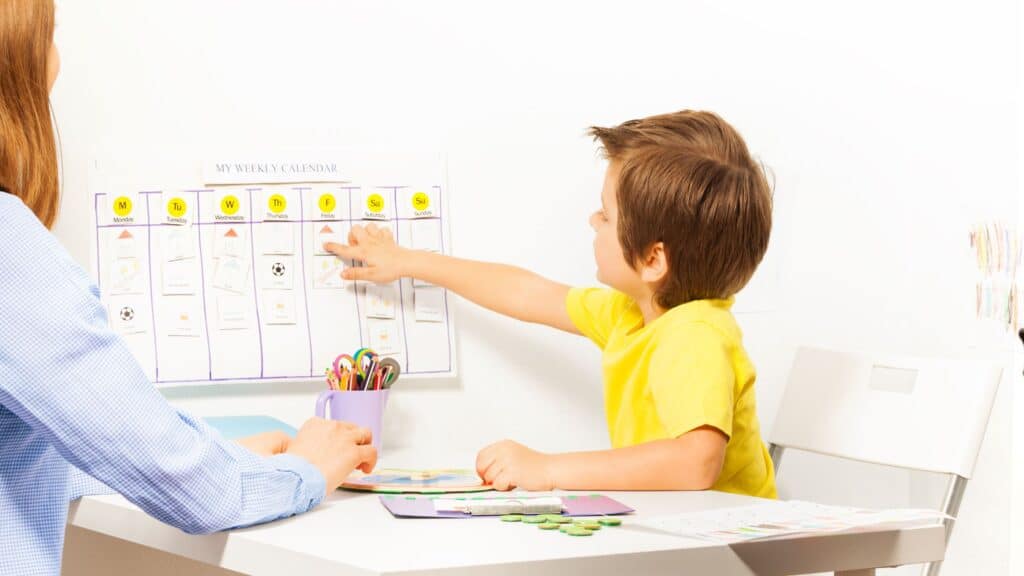As parents, we’re constantly balancing school schedules, work demands, activities, sports, meals, and everything in between so it’s no wonder why so many families feel like they’re always one step behind.
Add a caregiver into the mix—whether that’s a nanny, babysitter, or another trusted adult—and coordination becomes even more important. That’s why creating strong organization systems for home isn’t just helpful, but essential to keep your family organized and on track.
As the co-founder of Jam Family Calendar, an AI-powered shared calendar and coordination app, I’ve spoken to hundreds of families about the logistics of modern family life. I’ve seen behind the curtain of what works in homes and what doesn’t.One thing is always clear: when you have simple, consistent home organization systems in place, everyone benefits. Strong household organization isn’t just for parents’ peace of mind; they’re the framework that helps your caregiver also feel confident, capable, and aligned with your family’s needs.
Why Home Organization Systems Matter
When people hear “organization,” they often think of neatly labeled bins or picture-perfect pantries. Those are nice, but home organization systems go deeper than what you might see on your feed. They’re the processes and frameworks that keep the household running. They create clarity, predictability, and trust, especially when a caregiver is involved.
Here’s what strong systems deliver:
- Visibility: Everyone can see what’s happening when. (No more relying solely on long text chains or sticky notes!)
- Confidence: Caregivers know routines and expectations without needing constant check-ins.
- Reduced stress: Parents don’t have to carry the entire “mental load” of remembering everything and needing to constantly communicate changes. When everything lives in one system, changes can be made once and everyone sees them.
- Flexibility: Life changes,but when systems are in place, it’s much easier for key family stakeholders to adapt and get back on track quickly.
These systems aren’t about being perfect 24/7 because we all know that life is unpredictable sometimes! A strong organization system is about creating the scaffolding that allows families and caregivers to thrive together.
Shared Systems: The Parent–Caregiver Partnership
Your caregiver is a key team member in your household. Like any good team, alignment comes from having shared tools and shared expectations. Without them, things can feel scattered and reactive. With them, everyone is empowered to contribute and are held accountable for their responsibilities.
If you’ve ever relied solely on last-minute texts or handwritten notes to keep your caregiver in the loop, you know how quickly things fall through the cracks. A last-minute practice cancellation. A double-booked appointment. Surprise items needed for school by tomorrow.
That’s why shared systems matter so much. They serve as a single source of truth, ensuring all the tasks, responsibilities and daily must-haves are accessible to everyone who needs it. A shared family calendar, for instance, means caregivers never have to wonder what time pickup is or whether practice is canceled. A shared grocery list ensures whoever makes it to the store knows exactly what’s needed.
When parents and caregivers are connected through the same framework, it shifts the dynamic from reactive to proactive. It builds trust, efficiency and reduces friction because everyone’s working from the same playbook.
Practical Ways to Build Organization Systems for Home
Now let’s get into the details. Here are a few systems that are both high-level in philosophy and practical enough for busy families to implement right away.
1. Shared Calendar
A calendar is the backbone of any home organization system. (We’ve all heard the adage, “If it’s not on the calendar, it doesn’t exist!”) Whether it’s filled with feedings, music class and naptimes for younger babies, or school carpool times, playdates, appointments and extra-curriculars for older kids, knowing what’s on deck each day keeps things humming smoothly.
While a paper calendar that hangs in the kitchen worked for previous generations, families today need something more flexible and nimble. With daily schedules changing on the fly so much these days, a digital calendar that everyone can see and update in real time is table stakes for modern families.
Tools like Jam Family Calendar allow families to tag who is going to events, who is driving and invite caregivers (and kids!) to their family dashboard, giving them visibility to the calendars and schedules they want them to be part of. For example, tag your caregiver on the pick up they’re responsible for and not only will it go in the calendar for everyone to see, but they’ll get automatic reminders sent to their mobile for it as well.
The beauty of a shared calendar is that it allows everyone in the family to be more empowered and responsible, cuts down on the need for constant communication and allows both parents and caregivers peace of mind that everyone knows what the plan is.
2. Shared Lists
Lists are the unsung heroes of household organization. With shared digital lists, both you and your caregiver can again operate off the same playbook.
- Shared Shopping Lists. A shared shopping list means caregivers can add food and supplies when they see them run low, reducing the mental load on parents to track everything. In addition, if your caregiver goes to the store for you, a shared list ensures they always know what you need them to grab.
- Team To-Do Lists. A shared to-dolist with your caregiver streamlines expectations and reduces miscommunication. Oftentimes, we rattle off a list of things we want done verbally and then frustration sets in as some items fall through the cracks, or misunderstandings arise. (Ditto for text chains, where you have to scroll up for a while to find the initial request!) For households with more logistics, a shared digital list that allows for assigning and due dates can be even more helpful.
- Packing Lists. Set lists with what needs to get brought to certain events (like dance practice) help caregivers and parents align. Jam offers a “What to Bring” section in their events, but even a shared list of what items are needed for various extracurriculars makes it easier for caregivers to make sure your kids have what they need.
While writing lists on a scrap of paper will work in a pinch, a unified shared list system ensures a consistent framework for the entire family. If you choose to keep it old school, keep your paper lists in the same location in your home, and clearly review it and how you’d like it to be used. If you choose digital, you’ll gain better visibility into what’s getting done and the ability to set certain recurring to-do’s each week.
3. Household Routines
Calendars and lists cover logistics, but routines cover the daily flow. Kids thrive on structure, and caregivers feel more confident when they know the playbook.
Create simple routines like:
- Morning checklist: Breakfast, teeth brushed, backpack packed.
- Evening flow: Dinner, homework, playtime, bedtime routine.
- Chore system: Clear expectations for what kids (and caregivers) are responsible for each day.
Every household runs differently. Keep in mind that your caregiver may have been in a home before yours where there were different priorities or expectations. Establishing your family’s unique routines allow parents, caregivers and kids to understand the daily expectations so there are less meltdowns and anxiety, and more smooth sailing. These routines don’t need to be rigid (unless you want them to be). Instead, think of them as flexible frameworks that create predictability, which is invaluable for both children and caregivers.
While these can be communicated in a variety of ways, having a shared digital hub where these routines “live” allow everyone to check in on them as often as they’d like, to check things off throughout the morning/evening and to update them easily.
Coordinating with Your Caregiver
The best tools are most effective when communicated clearly and often. Here are a few ways to bring your caregiver into your system seamlessly:
- Introduce the “why”: Share how your systems aren’t about micromanagement, but about making life easier for everyone, including them.
- Keep it simple: Start with one or two tools (like a shared calendar and grocery list). Don’t overwhelm with too many apps or rules, and then gradually introduce more as desired
- Have a weekly sync: A short check-in each week to review schedules, update lists, and highlight anything new or special makes all the difference.
- Encourage ownership: Invite your caregiver to add to lists, update the calendar, and suggest improvements. Shared systems work best when everyone feels invested.
Why Systems Are Amazing
Life with kids will always bring surprises, but when you have organization systems for home in place, you’re never starting from scratch. Systems provide the framework that makes it easy to adapt and bounce back quickly.
For parents, that means less stress and more peace of mind. For caregivers, it means clarity, confidence, and autonomy. And for kids, it means a smoother, more predictable routine.
At Jam Family Calendar, we believe that systems are the foundation of a calmer, more connected family life. They don’t eliminate the chaos, but transform how you navigate it, together.
Because in the end, systems aren’t about rigidity. They’re about resilience, alignment, and giving families more space for what matters most.
Jessica Etting is the Co-Founder and CEO of Jam, an AI-powered shared calendar and coordination app built for modern family life. Jam merges calendars, to do’s, shopping and more onto one collaborative platform to streamline logistics and reduce the mental load for busy parents.
Try Jam for free for a full month + get 30% off with this special link from Hello Nanny or use the code HN30 when you sign up!



